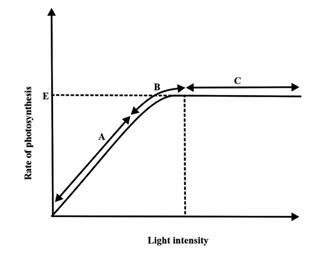The figure shows the effect of light on the rate of photosynthesis. Based on the graph, answer the following question:
At which point/s (A, B or C) in the curve is light a limiting factor?



Important Points to Remember in Chapter -1 - Photosynthesis in Higher Plants from NCERT BIOLOGY Textbook for Class XI Solutions
1. Photosynthesis:
(i) Photosynthesis is a physio-chemical process used by plants and other organisms to convert light energy into chemical energy for the synthesis of organic compounds.
(ii) During photosynthesis, carbon dioxide from the atmosphere is taken in by leaves through stomata and used for making carbohydrates, principally glucose and then starch.
(iii) Photosynthesis has two stages: the light reaction and the carbon-fixing reaction.
(iv) Part of the spectrum used in photosynthesis has a wavelength between 400nm-700nm. It is called photosynthetically active radiation.
2. Site of photosynthesis:
(i) Photosynthesis occurs only in the plants' green parts, mainly in the chloroplast of leaves.
(ii) Chloroplast has two main parts: grana (lamellar system) and stroma. Each granum is composed of grana lamellae or thylakoids and the stroma is a proteinaceous matrix.
(iii) The photosynthetic pigments are usually located within the membranes of thylakoid.
(iv) Within the chloroplasts, the membranes are sites for the light reaction, while the chemosynthetic pathway occurs in the stroma.
3. Pigments involved in Photosynthesis:
(i) In the light reaction, the light energy is absorbed by the pigments present in the antenna, and funnelled to special chlorophyll-a molecules called reaction centre chlorophylls.
(ii) There are two pigment-protein complexes- (a) Photosystem-I (PS-I) and (b) Photosystem-II (PS-II).
(iii) PS-I has a absorbing chlorophyll- a molecule at its reaction centre, while PS-II has a reaction centre that absorbs red light at
(iv) The amount of absorption of light at different wavelengths is called the absorption spectrum.
(v) When the actual rate of photosynthesis in terms of evolution is measured as a function of wavelength, it is called action spectrum.
(vi) The most effective wavelength is in the red region.
(vii) ATP and are produced as a result of cyclic and non-cyclic photophosphorylation.
(viii) PS- is involved in cyclic and non-cyclic transport while PS- is in non-cyclic one only.
(ix) PS- is concerned with ATP production while PS- in ATP and both.
4. Light Reaction:
(i) In light reaction, the photo-oxidation of water takes place to evolve molecules along with release of protons and electrons.
(ii) After absorbing light, electrons are excited and transferred through PS- and PS- and finally to NAD forming NADH.
(iii) Splitting of water molecules is associated with PS- resulting in the release of protons and transfer of electrons to PS-.
5. Dark reaction:
(i) Dark reaction is associated with reduction of accomplished by ATP and produced in light reaction.
(ii) The dark reaction has three types of reactions: carboxylation, reduction and regeneration.
(iii) Carboxylation of ribulose bisphosphate (RuBP) takes place by RuBP carboxylase.
(iv) The primary product formed as a result of carboxylation is phosphoglyceric acid (PGA) which undergoes reduction by ATP and to produce triose phosphates.
(v) Finally triose phosphates undergo many reactions to produce hexose sugars which are stored as starch.
(vi) Those plants which have primary product PGA (carbon compound) are called plants.
6. The C4 Pathway:
(i) Some tropical plants show a special type of photosynthesis called pathway or Hatch and Slack pathway.
(ii) plants are those plants where a primary product is a carbon organic acid.
(iii) In plants, acceptor is phosphoenolpyruvate (PEP) in place of RuBP.
(iv) PEP remains present in the mesophyll cells.
(v) The carbon oxaloacetic acid (OAA) is formed in the mesophyll cells. It is then converted to other four-carbon compounds like malic acid or aspartic acid in the mesophyll cells.
7. Photorespiration:
(i) RuBisCO, the most abundant enzyme on the planet, characterised with its active site and can bind to both O2 and CO2.
(ii) O2 binds with RuBisCO in C3 plants, leading to the formation of phosphoglycerate and phosphoglycolate via a pathway known as photorespiration.
(iii) Photorespiration does not occur in C4 plants, so they are more productive.
8. Factors Influencing Photosynthesis:
(i) The photosynthesis rate is affected by both internal and external factors. Internal factors include the number, size, age, alignment of leaves, chloroplasts, and so on, as well as external factors such as CO2 concentration, temperature, water, etc.
(ii) Blackman's (1905) Law of Limiting Factors comes into play, which states that if a chemical process is affected by more than one factor, the rate will be determined by the factor that is nearest to its minimal value, which is known as the Limiting factor.
(iii) Light is being used as 10% of the incident sunlight. It is directly proportional to CO2 fixation at low intensities.
(iv) Excessive light causes the breakdown of chlorophyll, resulting in a decrease in photosynthesis.
(v) Carbon dioxide concentrations in the atmosphere are very low, ranging from 0.03 to 0.04 percent, an increase in the concentration of up to 0.05 percent can cause an increase in photosynthesis rate.
(vi) Dark reactions are enzymatic; they are temperature controlled. C4 plants react to higher temperatures and have higher photosynthesis rates, whereas C3 plants have a lower temperature optimum.
(vii) Water stress leads to the closing of stomata, reducing carbon dioxide accessibility, and causing leaves to wilt, thus reducing the surface area.
